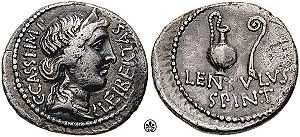Lituus


The word lituus originally meant a curved augural staff (cp. "crozier") or a curved war-trumpet in the ancient Latin language. In English it is used with several meanings.
Roman ritual wand
The lituus was a crooked wand (similar in shape to the top part of a crosier) used as a cult instrument in ancient Roman religion by augurs to mark out a ritual space in the sky (a templum). The passage of birds through this templum indicated divine favor or disfavor for a given undertaking. The lituus was also used as a symbol of office for the college of the augurs to mark them out as a priestly group.
Music instrument
Ancient lituus
The ancient lituus was an old Etruscan high-pitched brass instrument, which was bent at the end, similar to the Gallic carnyx. It was later used by the Romans, especially for processional music and as a signalling horn in the army.[1] In 17th century Germany a variant of the bent ancient lituus was still used as a signalling horn by nightwatchmen.
Medieval lituus
The mediaeval lituus was a different brass instrument from the ancient Etruscan instrument, described by Kürzinger (1763) as a variant of the early trumpet or horn, i.e. a later development of the ancient Roman tuba. One of the last compositions orchestrated for the mediaeval lituus was Bach's motet O Jesu Christ, meins Lebens Licht (BWV 118). Scientists from Edinburgh University tried to recreate the lituus in May 2009, when the instrument had been out of use for 300 years.[2][3]
References
| Wikimedia Commons has media related to Lituus. |
| Wikisource has the text of the 1911 Encyclopædia Britannica article Lituus. |
- ↑ Picture of reconstructed Roman lituus.
- ↑ Pallab Ghosh (30 May 2009). "'Lost' music instrument recreated". BBC News. BBC. Retrieved 30 May 2009.
- ↑ Engineering and Physical Sciences Research Council (EPSRC) (1 June 2009). "Scientists recreate Bachs forgotten horn". EPSRCvideo. YouTube. Retrieved 1 June 2009.